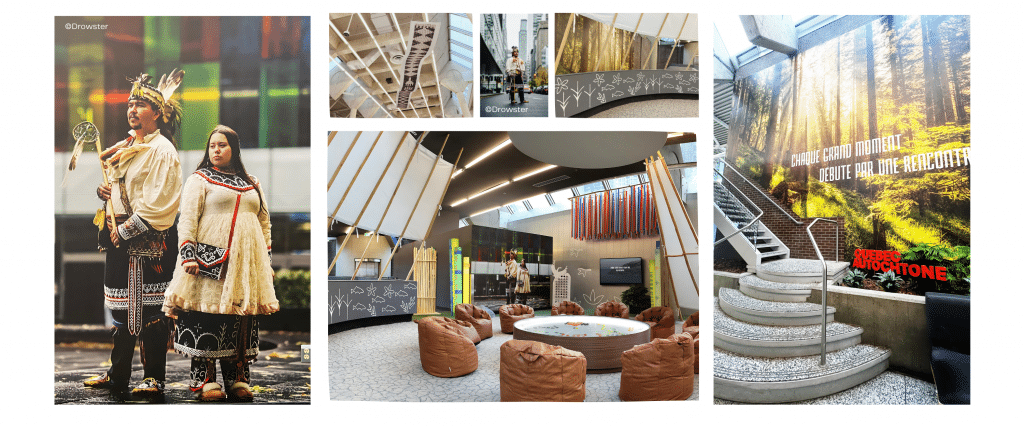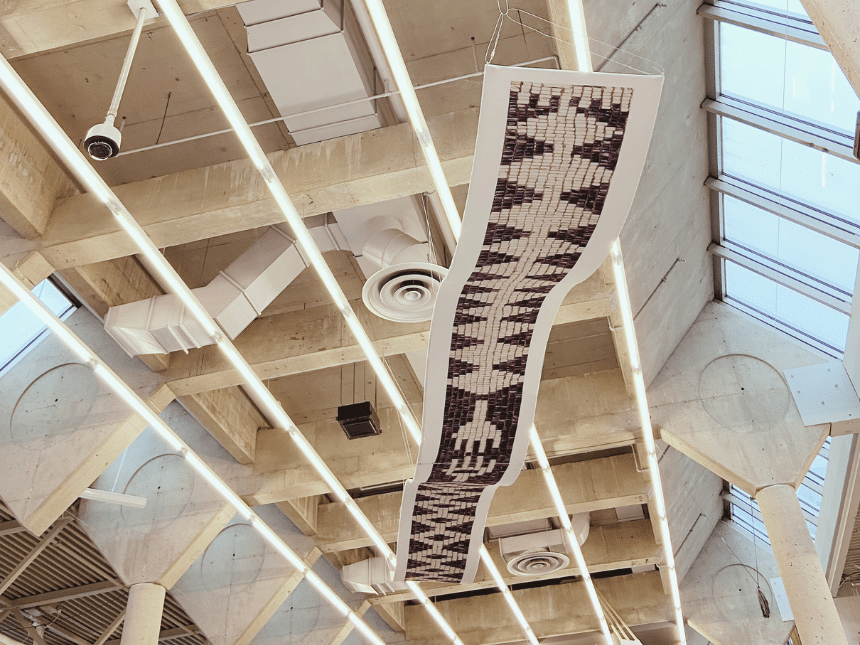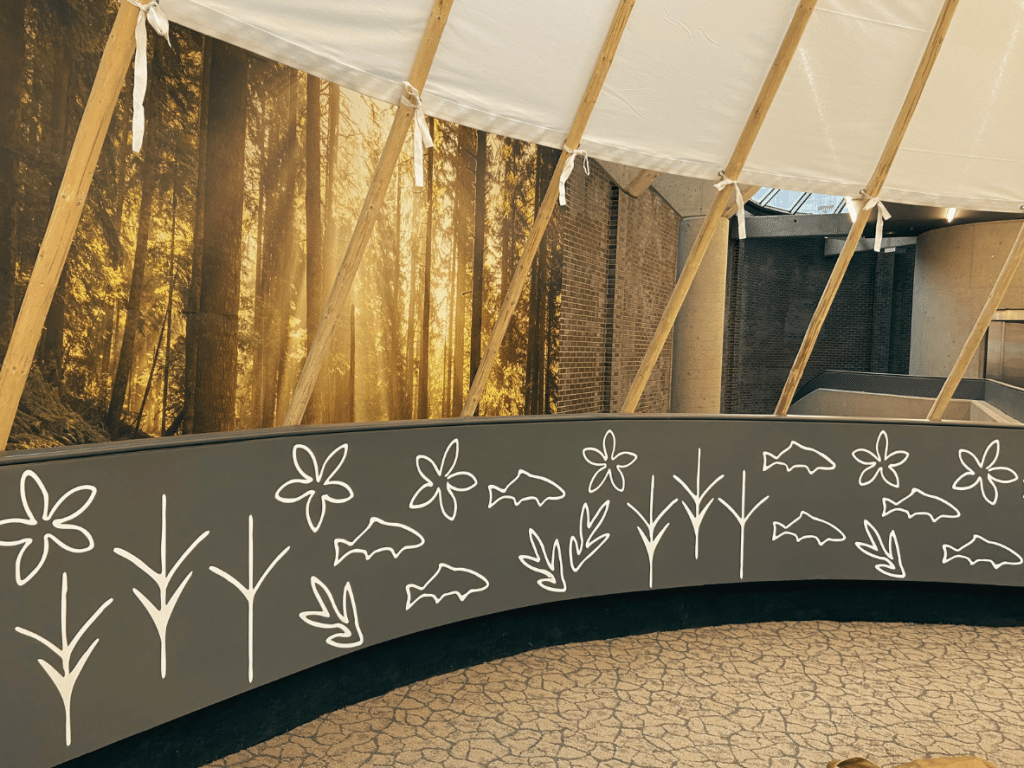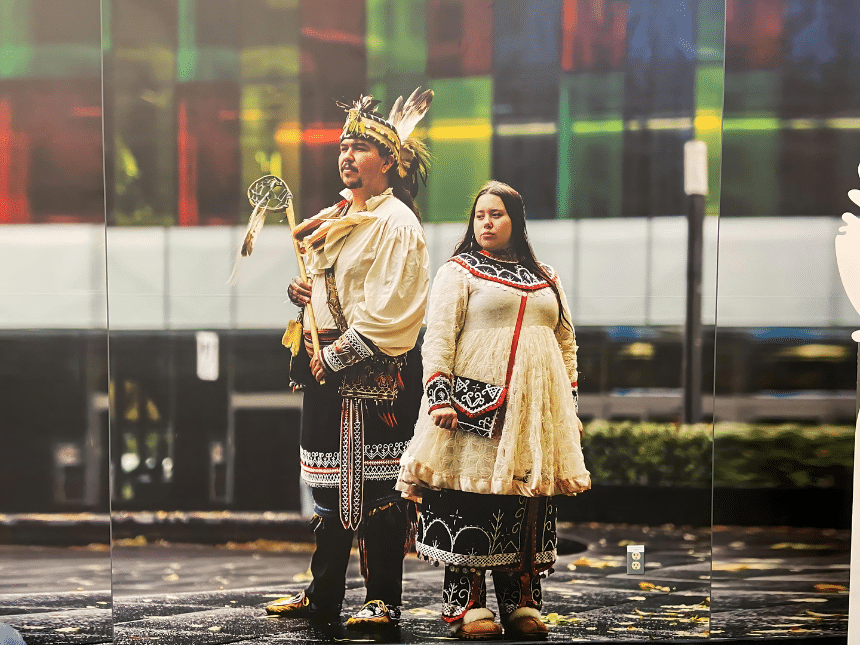Adjust the text size as needed by clicking the buttons below.
Adjust the visual style of the site by selecting the one that suits you best from the choices available below:
Adjust the text size as needed by clicking the buttons below.
Adjust the visual style of the site by selecting the one that suits you best from the choices available below:
The Palais des congrès de Montréal and Indigenous Tourism Québec unveil QUÉBEC AUTOCHTONE (Indigenous Québec), a convivial networking space to discover the tourism offer of Québec’s 11 Indigenous Nations.
For convention-goers from around the world, QUÉBEC AUTOCHTONE responds to the public’s growing interest in Indigenous cultures, and the expectations of a rapidly-changing events industry. Indeed, beyond the content of conventions, business travelers are seeking unique experiences—ones that provide cultural encounters and discoveries. A resolutely innovative demand that is creating bridges between business tourism and leisure tourism.
Inspired by Indigenous Tourism Québec’s powerful theme, “All memorable stories start with an encounter,” QUÉBEC AUTOCHTONE captures the Palais des congrès’ desire to transform the convention-goer’s visit into a moment of sharing. For thousands of years, Indigenous Québec has been unique in its cultures that combine ancestral and contemporary traditions. With this thematic space, the Palais des congrès and Indigenous Tourism Québec offer business travelers an informal place of encounter along with an opportunity to immerse themselves in a unique, high-quality and authentic tourism offer.
This new zone is the latest addition to the Palais’ offering of flagship experiences in Québec since 2019, created in close collaboration with Vannoote Design: LE CHALET, transporting visitors to a wooded environment; LA STATION, evoking an après-ski ambience; LE SAINT-LAURENT, an immersion in the marine life of the St. Lawrence River; and LE PANORAMA. Soon to be unveiled, this latest space will plunge visitors into a variety of nature experiences. LA STATION, LE SAINT-LAURENT and LE PANORAMA were designed in collaboration with the Alliance de l’industrie touristique du Québec, as part of a new mandate from the Québec Ministry of Tourism to promote the destination under the brand Bonjour Québec.

By combining their know-how, the Palais des congrès de Montréal and Indigenous Tourism Québec, in collaboration with interior designer Gérard Vannoote and several other contributors, developed a space that provides a window on the living heritage of First Nations and Inuit.
This intimate, welcoming space, in the form of a circle, is encompassed by a structure of wooden poles carved by Innu designer and artisan Serge Ashini Goupil. Like the inside of a teepee, it evokes the cycle of life, the circle being an important symbol for Indigenous peoples. On a central table, a 3D map situates the 55 Indigenous communities in Québec. The emblems of each of the 11 Nations adorn the space, along with large-format photographs depicting dancers, members of the Kahnawà:ke community, in their traditional dress. Lastly, a 12-metre (40-foot) wampum belt suspended from the ceiling takes pride of place in the Palais’ Viger Hall. This belt, made of marine shell beads, represents peace and fraternity among peoples—a reminder that this site is a welcoming place for visitors from around the world.
With a dynamic interface, visitors will be able to tangibly discover the Indigenous tourism offer, and some 200 experiences related to art and culture, hunting and fishing, gastronomy, festivities, accommodation, and nature and adventure. A unique and authentic look at the richness of Québec’s Indigenous tourism!
To broaden and sustain their partnership, the Palais des congrès de Montréal and Indigenous Tourism Québec will roll out other initiatives in the coming weeks. A thematic menu inspired by Indigenous culinary traditions will be created by Maestro Culinaire, the Palais’ exclusive food service provider. An Awareness-raising workshop on Indigenous realities in a tourism context (“Indigenous tourism: a tool for bringing communities closer together and responding to the population’s desire to learn more about Indigenous history, traditions and realities”) will be offered to the Palais’ team. Lastly, a client Legacy Program will be put in place by the Palais to bring to life the QUÉBEC AUTOCHTONE space through various activities and events.
In addition to this space, several events organized by and for Indigenous peoples will be held at the Palais des congrès, including the Assembly of First Nations, from July 9 to 11, 2024, and the International Indigenous Tourism Conference, in February 2025.
We can’t experience all of Québec’s richness without shining a light on the cultural, heritage and artistic tourism of the 11 Indigenous Nations. It’s an honour for the Palais des congrès de Montréal to offer a place of encounter between people from around the world and the tourism treasures of the peoples who have lived on and protected Québec since the dawn of time.
– Emmanuelle Legault, President and CEO of the Palais des congrès de Montréal
The QUÉBEC AUTOCHTONE space will allow thousands of convention-goers from around the world to enjoy a revelatory moment, swept up by the magnificence of the Indigenous tourism offer in Québec. This partnership with the Palais des congrès de Montréal is not only innovative, it’s a great step toward bringing communities closer together. We’re grateful and energized as a sectoral tourism association and proud that this promising initiative is taking root in Montréal.
– Dave Laveau, Executive Director of Indigenous Tourism Québec
ITQ is the tourism industry association recognized by the Ministry of Tourism as the official spokesperson for Indigenous tourism, and by the Assembly of First Nations of Québec and Labrador as the representative of an exchange and service centre for the development and promotion of the Indigenous tourism offer. Our mission: to guide and propel the success of Indigenous entrepreneurs in tourism markets through our strengths: human-centered relations, expertise, advice, networks and strategies. indigenousquebec.com

The pictograms of the Nations were created during the redesign of the Indigenous Tourism Québec website in 2012, and then reworked by Récréation as a core aspect of Indigenous Tourism Québec’s brand image. These pictograms were designed by a non-Indigenous graphic designer, in 2012, with upstream guidance from each Nation.

The carved wooden poles and the canvas illustrate the materials used to make traditional Innu houses.

3D map situating the 55 Indigenous communities in Québec.

L 12 m
Reproduction of a wampum belt, an object made of marine shell beads to convey words, messages, principles, alliances and more, between different Nations.
This one, adapted by the Ideation Committee for the QUÉBEC AUTOCHTONE space, represents encounter, reconciliation and sharing among the 11 Nations of Québec that are opening their doors for tourism to 11 visitors from around the world.
The diamond-shaped figure symbolizes a nation or a people; the white represents purity, honesty, peace and alliance; and the hands symbolize encounter and sharing.

Illustrations of fish – Ispehew: in Atikamekw language, symbolizes the concept of being carried by the current, going with the flow.
Illustrations of geese – Takocirew: in Atikamekw language, means arrival at a destination, landing.

Featured: Kaiwate Jacobs (R) and Owen Skahionwiio Mayo (L), of the Kanien’kehá:ka Nation of Kahnawà:ke.

Indigenous realities today are tainted by historical events that have had serious intergenerational repercussions. The Ideation Committee thought it necessary to create a work that highlights these realities in a spirit of reconciliation and respect.